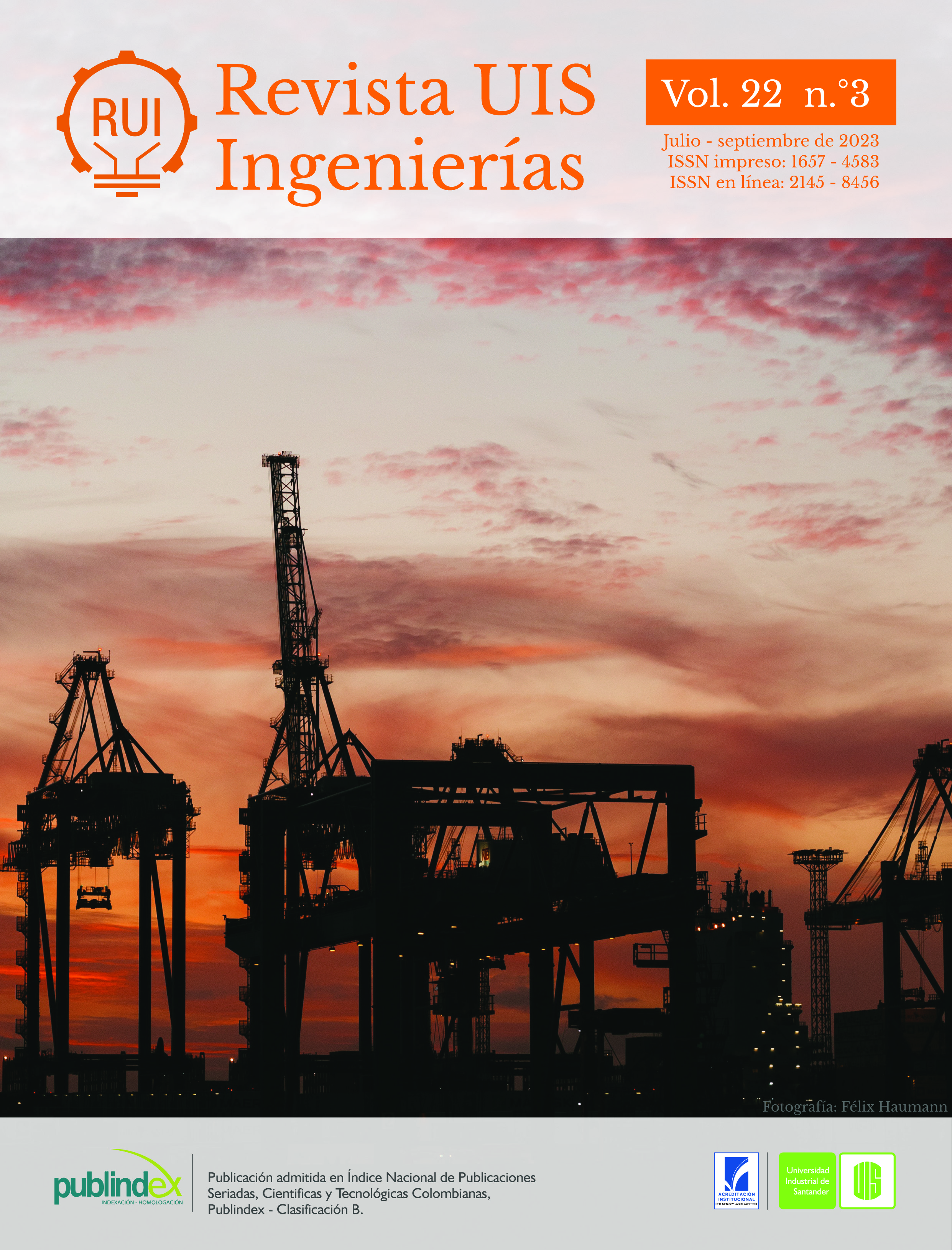Development of construction mortars with geopolymers obtained from soils degraded by mining in Bajo Cauca Antioquia
Published 2023-06-17
Keywords
- geopolymer,
- alkaline activator,
- mortars,
- degraded soils,
- mining waste
- fly ash ...More
How to Cite
Copyright (c) 2023 Revista UIS Ingenierías

This work is licensed under a Creative Commons Attribution-NoDerivatives 4.0 International License.
Abstract
In the present work, mortars with geopolymer were obtained from degraded soils from mining activities as a circular economy process. For this purpose, a granulometric classification of the degraded soil was initially carried out to obtain particles with a size of less than 750 µm, which were used in the mixture as fine aggregates. For the cementitious phase, mixtures of degraded soil with size less than 45 µm (obtained through a grinding process of the fine aggregate) and fly ash (with size < 45 µm), alkaline activated, were used. The particle size of the soils was determined by laser diffraction. In addition, a chemical evaluation of the geopolymer precursors was carried out by X-ray fluorescence and scanning electron microscopy was used for the analysis of both the soils and the manufactured geopolymer mortars; density and compressive strength tests were carried out. The results obtained indicate that ground soil particles with a size smaller than 45 µm were obtained in percentages higher than 91.7 %, which presented a high content of aluminosilicates: SiO2 (81.7 % p/p) and Al2O3 (12.51 % p/p). In addition, a morphology of irregular grains and sticks was observed in the mortars with developed geopolymers.
Downloads
References
- J. L. O. Rivera, J. J. M. Galvis, “Producción y exportaciones de metales preciosos en Colombia,” 2019.
- L. N. Beltrán-Rodríguez, J. M. Larrahondo, D. Cobos, “Tecnologías emergentes para disposición de relaves: oportunidades en Colombia,” Boletín Ciencias la Tierra, no. 44, pp. 5–20, 2018, doi: https://doi.org/10.15446/rbct.n44.66617
- B. C. McLellan, R. P. Williams, J. Lay, A. van Riessen, G. D. Corder, “Costs and carbon emissions for geopolymer pastes in comparison to ordinary portland cement,” J. Clean. Prod., vol. 19, no. 9–10, pp. 1080–1090, 2011, doi: https://doi.org/10.1016/j.jclepro.2011.02.010
- MARCY ELIZABETH VALENZUELA HERRERA, “Estudio experimental de geopolímeros sintetizados a partir de puzolana natural,” Universidad de Chile, 2013.
- J. Coreño-Alonso, M. Méndez-Bautista, “Relación estructura-propiedades de polímeros,” Educ. Química, vol. 21, pp. 291–299, 2010, doi: https://doi.org/10.1016/S0187-893X(18)30098-3
- J. A. M. Canabal, A. J. M. Carvajal, “Aprovechamiento de desechos de ladrillo para la síntesis de geopolímero,” trabajo de grado, Universidad del Valle, 2015.
- L. A. V. Coraspe, “Situación actual de la síntesis y utilización de geopolímeros,” Gac. técnica, vol. 22, no. 2, pp. 23–38, 2021.
- S. A. D. Suarez, “Desarrollo de un procedimiento para la elaboración de geopolimeros optimizados,” trabajo de grado, Universidad Pedagógica y Tecnológica de Colombia, 2018.
- G.-M. Tsaousi, K.-M. Sakkas, D. Panias, “Development of advanced materials from industrial waste, with high thermal performance,” Constr. Build. Mater., vol. 315, p. 125779, 2022, doi: https://doi.org/10.1016/j.conbuildmat.2021.125779
- J. L. Provis, J. S. J. van Deventer, “Geopolymerisation kineticsReaction kinetic modelling,” Chem. Eng. Sci., vol. 62, no. 9, pp. 2318–2329, 2007, doi: https://doi.org/10.1016/j.ces.2007.01.028
- M. Torres-Carrasco, F. Puertas, “La activación alcalina de diferentes aluminosilicatos como una alternativa al Cemento Portland: cementos activados alcalinamente o geopolímeros,” Rev. Ing. construcción, vol. 32, no. 2, pp. 05–12, 2017, doi: https://doi.org/10.4067/S0718-50732017000200001
- J. D. Yepes, O. N., Bedoya, C. M. & Gómez, “Hacia un avance ambiental y tecnológico de la construcción con tierra como patrimonio futuro. Del bloque de suelo cemento (bsc ) al bloque de tierra con geopolímeros (btg )Em direção a um progresso ambiental e tecnológico da construção com terra como hera,” [Online]. Available: http://hdl.handle.net/10554/23195
- A. G. G. TORRES, “Obtención y caracterización de geopolímeros sintetizados a partir de la escoria granulada de alto horno como uso alternativo del cemento Portland,” trabajo de grado, Universidad Nacional de Colombia, 2017.
- L. Zhang, S. Ahmari, and J. Zhang, “Synthesis and characterization of fly ash modified mine tailings-based geopolymers,” Constr. Build. Mater., vol. 25, no. 9, pp. 3773–3781, Sep. 2011, doi: https://doi.org/10.1016/j.conbuildmat.2011.04.005
- P. Duxson, J. L. Provis, G. C. Lukey, S. W. Mallicoat, W. M. Kriven, J. S. J. van Deventer, “Understanding the relationship between geopolymer composition, microstructure and mechanical properties,” Colloids Surfaces A Physicochem. Eng. Asp., vol. 269, no. 1–3, pp. 47–58, 2005, doi: https://doi.org/10.1016/j.colsurfa.2005.06.060
- J. Kiventerä, L. Golek, J. Yliniemi, V. Ferreira, J. Deja, and M. Illikainen, “Utilization of sulphidic tailings from gold mine as a raw material in geopolymerization,” Int. J. Miner. Process., vol. 149, pp. 104–110, Apr. 2016, doi: https://doi.org/10.1016/j.minpro.2016.02.012
- M. A. Longhi, E. D. Rodríguez, B. Walkley, Z. Zhang, A. P. Kirchheim, “Metakaolin-based geopolymers: Relation between formulation, physicochemical properties and efflorescence formation,” Compos. Part B Eng., vol. 182, p. 107671, Feb. 2020, doi: https://doi.org/10.1016/j.compositesb.2019.107671
- P. Ambiente, “Materiales zeoliticos obtenidos a partir de cenizas volantes activadas por fusión alcalina Zeolitic materials obtained from fusion activated fly ashes,” en XII Jornadas Argentinas de Tratamientos Minerales, pp. 285–290, 2014.
- P. Kinnunen et al., “Recycling mine tailings in chemically bonded ceramics – A review,” J. Clean. Prod., vol. 174, pp. 634–649, 2018, doi: https://doi.org/10.1016/j.jclepro.2017.10.280
- Y.-M. Liew, C.-Y. Heah, A. B. Mohd Mustafa, H. Kamarudin, “Structure and properties of clay-based geopolymer cements: A review,” Prog. Mater. Sci., vol. 83, pp. 595–629, 2016, doi: https://doi.org/10.1016/j.pmatsci.2016.08.002
- M. M Giraldo, J. Tobón, “Evolución mineralógica del cemento portland durante el proceso de hidratación,” Dyna, vol. 73, no. 69-82, 2006.
- T. Pique, A. Vázquez, “Uso de Espectroscopía Infrarroja con Transformada de Fourier (FTIR) en el estudio de la hidratación del cemento,” Concreto y Cem. Investig. y Desarro., vol. 3, pp. 62–71, 2012.

